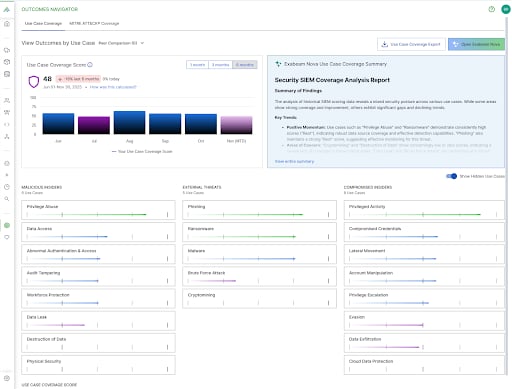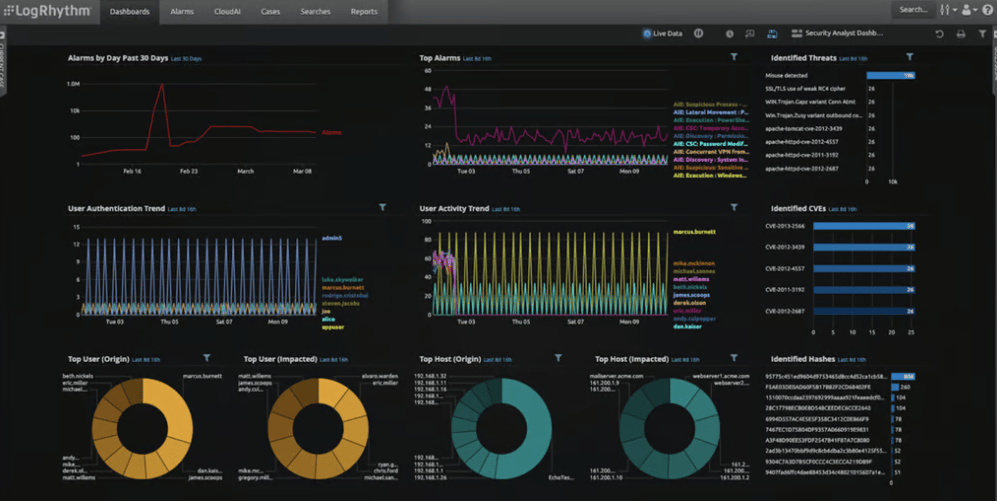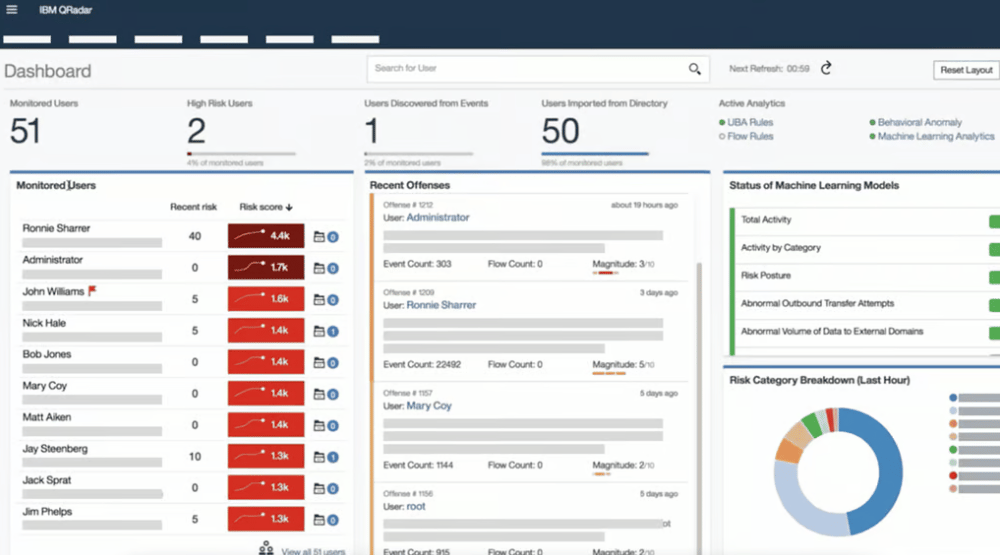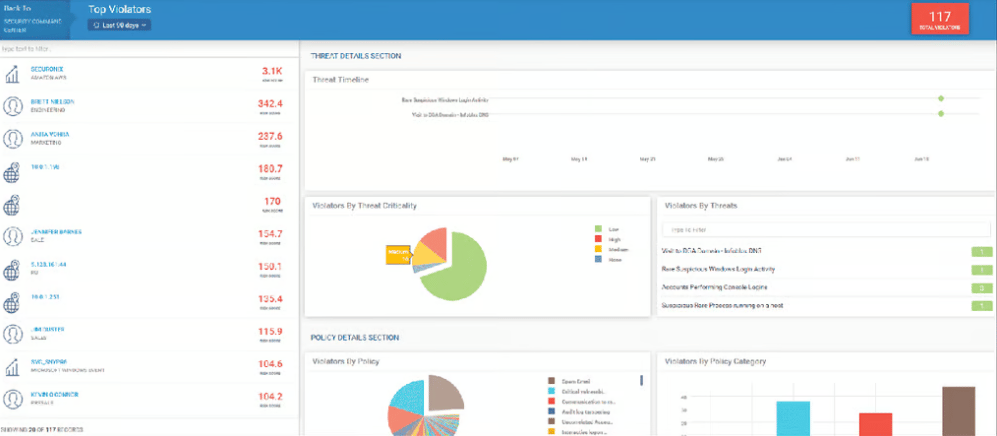editorially independent. We may make money when you click on links
to our partners.
Learn More
Security information and event management (SIEM) is a critical enterprise technology that pulls data from IT and cybersecurity systems to assess threats and manage risks. SIEM facilitates real-time monitoring, compliance adherence, and identification of anomalous activities. To help you choose the best SIEM tool tailored for your needs, we’ve evaluated the leading SIEM solutions in the marketplace, their best features, and limitations.
Here are the six best SIEM tools and software to consider:
Comparing the Top SIEM Software & Tools
Overall Reviewer Score
4.54/5
Ease of Use & Setup
4.4/5
Exabeam Fusion SIEM’s cloud-native platform unifies SIEM, UEBA, SOAR, and automated TDIR into a single solution. Its standout behavioral analytics and Smart Timelines help detect compromised accounts, insider threats, and abnormal activity with greater accuracy while reducing manual investigation work. The platform offers strong scalability through its New-Scale Fusion architecture, long-term searchable log retention, and an extensive library of integrations and prebuilt detections for faster onboarding.
Exabeam Fusion delivers powerful analytics and automated workflows, though pricing can vary depending on whether it augments or replaces an existing SIEM. For teams seeking intelligent detection, automated investigations, and streamlined response without heavy engineering overhead, Exabeam Fusion is one of the strongest cloud-native SIEM options available.
Vendor price: Contact Exabeam
Model: Flexible “augment or replace” approach that can sit on top of an existing SIEM or fully replace it
Free trial: Typically available upon request
Pros
- Best-in-class UEBA with deep identity and behavioral analytics
- True unified TDIR workflow — SIEM, UEBA, and SOAR in one platform
- High scalability via cloud-native New-Scale Fusion
Cons
- Pricing may be opaque depending on the chosen deployment model
- Advanced features may exceed the needs of very small teams
- Requires cloud adoption; limited on-prem suitability
Behavioral analytics: Native UEBA baselines user and entity activity to detect insider threats, compromised accounts, and abnormal behaviors that rule-based systems often miss.
Smart Timelines: Automatically builds attack narratives by correlating events across users and assets, reducing manual investigation steps and improving incident clarity.
Unified TDIR workflow: Integrates SIEM, UEBA, and response automation into a single platform, streamlining threat detection, investigation, and response without tool-switching.
Elastic cloud architecture: New-Scale Fusion scales dynamically to handle high or variable event volumes, offering strong performance for cloud-first and rapidly growing environments.
Prebuilt content & integrations: Hundreds of detections, dashboards, and playbooks plus 800+ integrations accelerate deployment, improve coverage, and shorten time-to-value.

Overall Reviewer Score
4.1/5
Ease of Use & Setup
3.9/5
LogRhythm SIEM Platform is a noteworthy on-premises SIEM solution, known for its log management, threat detection, and response capabilities. Its on-premises deployment secures data ownership and compliance, providing a scalable solution adapted to specific security requirements.
Beyond SIEM, LogRhythm delivers strong SOAR, UEBA, and NDR capabilities, available through on-premises hardware and software deployments designed for organizations that require full control over their security infrastructure. LogRhythm excels as an on-premises SIEM solution.
Vendor price: Contact LogRhythm’s sales team
Free trial: Not available
Pros
- A longtime, established provider of on-premises SIEM
- A strong network of MSPs and reselling partners
- User-friendly product interface and administration features
Cons
- Not suitable for cloud-native or SaaS-first environments
- Limited API and integration flexibility compared to cloud-native SIEMs
- Traditional update cadence aligned with on-premises release cycles
Advanced analytics: Detects malicious activities by evaluating patterns in compliance and security contexts, which improves proactive threat detection.
Prebuilt playbooks: Include alert triage, threat context, and case categorization to streamline incident response through preset, efficient workflows.
Accelerated detection: Automated workflows optimize threat detection and response, ensuring rapid remediation for effective incident resolution.
Threat intelligence: LogRhythm Labs offers useful insights, giving access to current and comprehensive threat intelligence for proactive defense.
Access to data: Provides wide access to more than 950 third-party data sources as well as 1,100 pre-configured correlation rule sets for richer, more efficient threat analysis.

Overall Reviewer Score
4.22/5
Ease of Use & Setup
3.9/5
Splunk Enterprise Security’s analytics-first solution is scalable to on-premisess or multi-cloud environments and has powerful threat detection capabilities. Notably, it provides powerful SIEM capabilities while demonstrating scalability via a platform that hosts thousands of apps and seamlessly connects data and workflows.
Splunk, known for its IT observability, is one of the best options for comprehensive insights into IT landscapes.
Vendor price: Contact Splunk
Free trial: Available for 60 days via Splunk Enterprise
Pros
- Comprehensive SIEM and security approach
- Flexible infrastructure and deployment
- Wide device integration
Cons
- Resource challenges for smaller teams
- Complex and potentially expensive pricing
- International support depth may differ across regions
Risk classification: Categorizes risks based on user and system compliance with various security frameworks, following established standards.
Scalable ingestion: Scalability is available for both structured and unstructured data ingestion, leading to efficient processing of a wide range of data kinds and quantities.
Built-in threat intelligence: Incorporates a threat intelligence management tool, which improves its ability to analyze and respond to developing cyberthreats effectively.
Versatile deployment: Deployable across cloud, IaaS, software, hardware appliances, or hybrid setups, providing flexibility for organizations with a wide range of needs.
700+ detections: Provides access to more than 700 detections, in line with frameworks such as MITRE, NIST, Kill Chain, and CIS 20 for complete threat identification and mitigation.

Overall Reviewer Score
4.08/5
Ease of Use & Setup
3.7/5
IBM Security QRadar SIEM is an enterprise favorite that has evolved alongside the SIEM market. IBM launched the IBM Security QRadar Suite to more effectively combine threat detection, investigation and response, SOAR, SIEM, EDR, and XDR in one platform service for hybrid cloud users.
Its global presence offers localized support, regional regulatory expertise, and expansive channels, making it a reliable choice across regions around the world.
Free version: Available but limited via QRadar Community Edition
Custom plans: Contact IBM for quote
Free trial: Available through certain MSSPs
Pros
- AI-driven with user behavior analytics and network flow insights
- Extensive global security portfolio and expertise
- Broad security ecosystem and seamless QRadar SIEM integration
Cons
- Challenging onboarding and implementation
- Outdated, complex user interface
- Concerns about product support and platform developments
Continuous monitoring: Maintains continuous surveillance across on-premises and cloud settings, providing full visibility along the kill chain.
Threat intelligence: Powered by IBM’s Security X-Force and STIX/TAXII feeds, which provide comprehensive threat information to enhance security measures.
Compliance resources: Offers comprehensive compliance support, including materials for HIPAA, SOX, ISO, PCI, NIST, GLBA, GDPR, and CCPA.
Versatile deployment: Offers deployment options, including hardware appliances, software, SaaS, and virtual machines, catering to on-premises and IaaS environments.
Integration access: Allows seamless integration with multiple security ecosystems by providing access to more than 450 interfaces, APIs, and an SDK.

Overall Reviewer Score
4.3/5
Ease of Use & Setup
4.0/5
Securonix, recognized for its innovative approach, also stands out for its SOAR integration capabilities. Its Unified Defense SIEM integrates seamlessly with SIEM, threat detection, investigation, and response.
The Autonomous Threat Sweeper for threat detection capitalizes on the Snowflake Data Cloud for improved data searchability. Its Threat Coverage Analyzer assesses security gaps aligned with industry standards such as MITRE ATT&CK and US-CERT.
Vendor price: Contact Securonix Security Operations and Analytics Platform
Free trial: Available for SaaS offering
Pros
- Integrated SOAR for accelerated incident response
- Playbooks and workflow guide reduce response time
- Built-in threat intelligence at no additional cost
Cons
- Limited role-based access control (RBAC)
- Steep platform learning curve
- Basic SIEM subscription is more expensive than others
Multi-environment ingestion: Has centralized ingestion for cloud, on-premises, and hybrid environments, with a uniform console to streamline data collection.
Long-term search: Enables extended analysis by providing comprehensive historical data search capabilities for detecting and managing slow-burning threats.
Cloud-native platform: Is designed for on-demand scaling, with a SaaS subscription model to provide flexibility and efficiency in cloud-based security operations.
Extensive cloud connectors: Access to 350+ connectors and API-based interfaces enables broad data collection from different cloud sources.
Use case content: With an investigative workbench, users can develop cases based on industry examples, which improves practical application and analysis.

Overall Reviewer Score
4.32/5
Ease of Use & Setup
4.4/5
Rapid7 offers a comprehensive SIEM platform with its flagship SIEM-XDR hybrid solution, InsightIDR. It solves the issues of over-indexing on endpoints or using only a restricted number of event sources.
Its deception suite, which includes honeypots, honey users, credentials, and files, improves threat detection throughout the attack chain. These traps use continuous attacker research to provide real-time, file-level visibility for effective security against breaches.
Custom plans: Contact Rapid7 for quote
Free trial: Available for 30 days
Pros
- Relatively easy to install
- 13 months of searchable data retention by default
- Has pre-built compliance content
Cons
- Limited automation
- High false positives
- Bandwidth-heavy system scans
Network traffic analysis: The curated intrusion detection system (IDS) focuses on actual threats. You can view extra network metadata to gauge the extent of activity.
UEBA: Automatically correlates network activities to specific individuals and entities.
Embedded threat intelligence: Detection library combines machine learning, enhanced attack surface mapping, and threat intelligence from the open-source community.
MITRE ATT&CK alignment: Uses MITRE framework to map attacker and UEBA detections. Reveals tactics, methods, and procedures most used by threat actors.
Deception technology: Provides four types of intruder traps and injects bogus honey credentials into your endpoints to deceive hackers.

SIEM tools often incorporate the best factors of other network security tools, such as advanced threat detection, endpoint/extended detection response (EDR/XDR) integration, MITRE ATT&CK mapping and support, and UEBA, to thoroughly detect vulnerabilities and threats.
When selecting a SIEM tool, consider the following top features and capabilities:
Advanced threat detection: Uses advanced algorithms and analysis techniques to detect and neutralize complex and developing cyberthreats.
EDR/XDR integration: Integrates capabilities for real-time monitoring, detection, and response to security issues on endpoints or across multiple environments.
Flexible infrastructure and deployability: Supports deployment flexibility across several environments, allowing enterprises to select on-premises, cloud, hybrid, or virtual configurations based on their individual needs and preferences.
Integration with threat intelligence platforms: Combines enterprise resource planning (ERP), big data, identity and access management (IAM), and threat intelligence platforms to improve overall security intelligence and context.
MITRE ATT&CK mapping and support: Aligns with the MITRE ATT&CK framework by providing a standardized mapping of adversary tactics, techniques, and procedures, facilitating threat intelligence analysis and improving detection capabilities.
Unified management, asset discovery, and compliance reporting: Provides a consolidated platform for streamlining security processes and ensuring regulatory compliance.
User and entity behavior analytics (UEBA): Tracks and analyzes patterns of user and entity activity to detect abnormalities to help identify potential insider threats or illegal access based on deviations from normal behavior.
How We Evaluated the Best SIEM Tools
eSecurityPlanet’s systematic evaluation classified our assessments into five categories: core features, cost, advanced features, ease of use and setup, and customer support – each with subcriteria. In order to provide a fair assessment, we assigned category ratings ranging from one to five for each specific subcriterion on our list.
Core Features – 25%
These are the main security posture capabilities of SIEM like threat hunting, efficient digital forensics, and effective incident response, unified management, compliance reporting, EDR/XDR integration, advanced threat detection, UEBA, and comprehensive integrity monitoring.
Criterion Winner: Multiple winners
Cost – 20%
Cost examines factors such as the availability of free trials, transparent and accessible pricing structures, scalability-oriented cost per workstation or server, and plan flexibility.
Criterion Winner:Rapid7 InsightIDR
Advanced Features – 20%
We considered additional but valuable capabilities such as vulnerability monitoring, SOAR integration, out-of-the-box content availability, and seamless integration with diverse platforms.
Criterion Winner:Exabeam Fusion
Ease of Use & Setup – 20%
Here, we evaluated high automation, accessible knowledge resources, minimal technical setup requirements, dashboard intuitiveness, and user experience on platforms like G2, Capterra, and TrustRadius.
Criterion Winner: Multiple winners
Customer Support – 15%
Reflecting the accessibility and effectiveness of customer service channels, we assessed live chat accessibility, email responsiveness, and the quality of documentation, demos, and training materials. It also reflects the user experience on platforms like G2 and Capterra.
Criterion Winner:Exabeam Fusion
To get an idea of how vital a SIEM platform is to enterprise security, consider the scale of security incidents and the data involved. A large enterprise may generate more than 25,000 events per second and require 50 TB or more of data storage. SIEM’s efficient data filtering prioritizes critical security issues, enhancing manageability. Choose the right tool to secure your digital operations and leverage free trials or demos for a test run before committing.
SIEM systems often rely on data from various security mechanisms, so knowing the common network security protections could help you interpret and prioritize these events more effectively.


